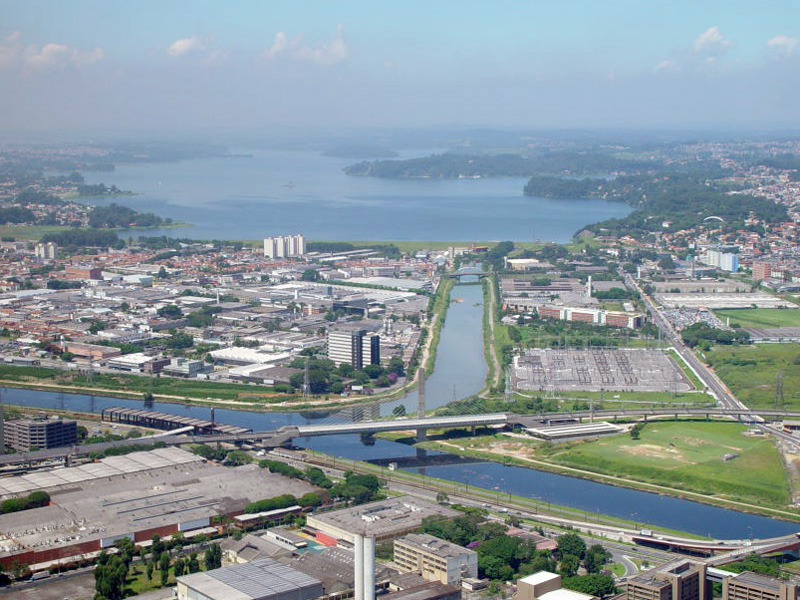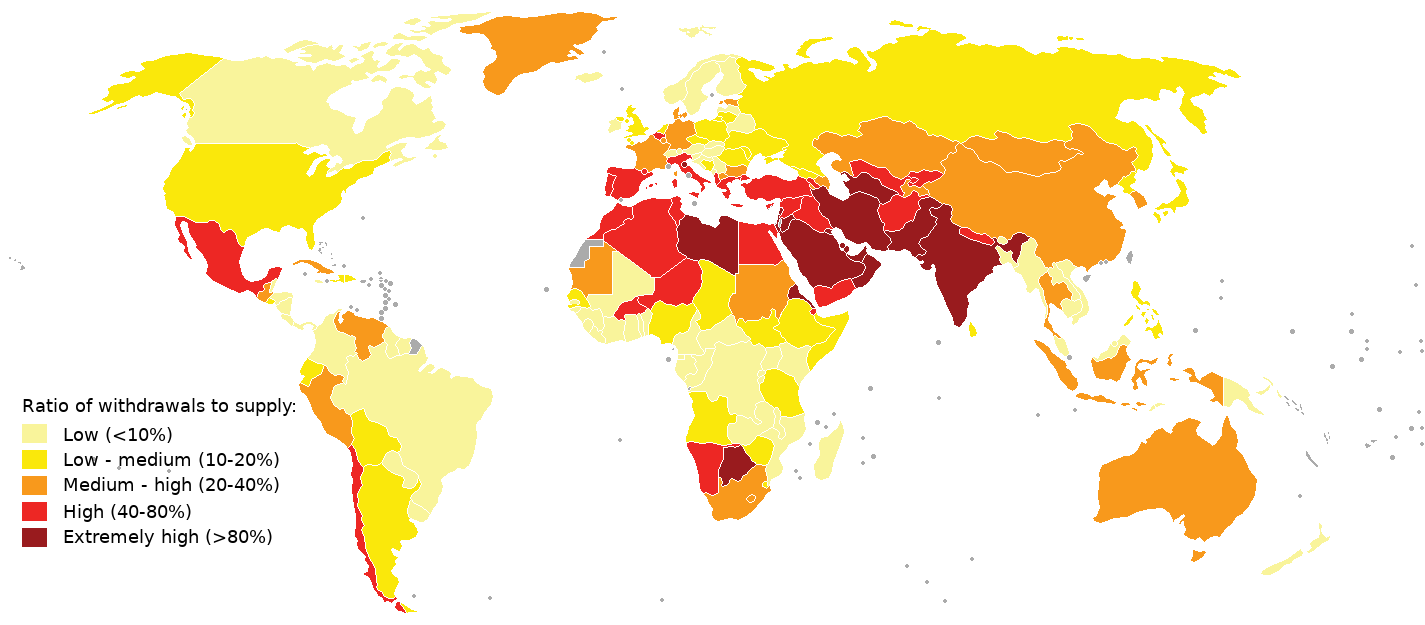|
Water Management In The Metropolitan Region Of São Paulo
Water management in the Metropolitan Region of São Paulo, Brazil faces several challenges, including pollution of drinking water reservoirs that are surrounded by slums, water scarcity leading to conflicts with the Campinas Metropolitan area to the north, inefficient water use, and flooding. The sprawling Metropolitan Region of São Paulo (MRSP) with close to 20 million people is the seventh most populous urban area in the world and the economic, financial and technical hub of Brazil. The main stakeholders in water management in MRSP are the state government, the state water and sanitation utility Sabesp and 39 municipal governments. A basin committee for the Alto Tietê basin, which covers the entire area of the MRSP and supplies half of its water, brings together all stakeholders. It has drawn up two master plans for the management of water resources in the basin. The first was approved in 2003 and focused on urban sprawl. The second was approved in 2009 and focused on wa ... [...More Info...] [...Related Items...] OR: [Wikipedia] [Google] [Baidu] |
Water Scarcity
Water scarcity (closely related to water stress or water crisis) is the lack of fresh water Water resources, resources to meet the standard water demand. There are two types of water scarcity: physical or economic water scarcity. Physical water scarcity is where there is not enough water to meet all demands, including that needed for ecosystems to function effectively. Desert climate, Arid areas for example Central and West Asia, and North Africa often suffer from physical water scarcity. On the other hand, economic water scarcity is caused by a lack of investment in infrastructure or technology to draw water from rivers, aquifers, or other water sources, or insufficient human capacity to satisfy the demand for water. Much of Sub-Saharan Africa has economic water scarcity. The essence of global water scarcity is the geographic and temporal mismatch between fresh water demand and availability. At the global level and on an annual basis, enough freshwater is available to meet such ... [...More Info...] [...Related Items...] OR: [Wikipedia] [Google] [Baidu] |
Guarulhos
Guarulhos () is a Brazilian municipality. It is the second most populous city in the Brazilian state of São Paulo, the 13th most populous city in Brazil, and is also the most populous city in the country that is not a state capital. In the last few years it has outgrown Campinas. It is part of the Metropolitan Region of São Paulo. Its population is 1,221,927 with an area of 318.68 km2. Overview The name comes from the Tupi language, and means "Eaters", "big-bellied people"; a reference to the original indigenous inhabitants of the area. It ranks eighth by GDP among Brazilian cities; second in São Paulo state. (source:IBGE, Brazil's national institute of statistics. GDP by cities report, published in 2005 with data from 2002). It is the tenth largest suburb in the world. The per capita income for the municipality is R$12,793. São Paulo-Guarulhos International Airport (GRU), one of the main Brazilian airports, is located there. The city is the seat of the Roman Catholic ... [...More Info...] [...Related Items...] OR: [Wikipedia] [Google] [Baidu] |
Surface Water
Surface water is water located on top of land forming terrestrial (inland) waterbodies, and may also be referred to as ''blue water'', opposed to the seawater and waterbodies like the ocean. The vast majority of surface water is produced by precipitation. As the climate warms in the spring, snowmelt runs off towards nearby streams and rivers contributing towards a large portion of human drinking water. Levels of surface water lessen as a result of evaporation as well as water moving into the ground becoming ground-water. Alongside being used for drinking water, surface water is also used for irrigation, wastewater treatment, livestock, industrial uses, hydropower, and recreation. For USGS water-use reports, surface water is considered freshwater when it contains less than 1,000 milligrams per liter (mg/L) of dissolved solids. There are three major types of surface water. Permanent (perennial) surface waters are present year round, and includes lakes, rivers and wetlands (marshe ... [...More Info...] [...Related Items...] OR: [Wikipedia] [Google] [Baidu] |
Pinheiros River
The Pinheiros River ( pt, Rio Pinheiros) is a most rectified inverted polluted water original sinuous course, today tributary of the Tietê River that runs through the city of São Paulo, Brazil. Until 1920, the river was together the river ''Jurubatuba'', a complex hydrography, most now disappeared. After being channelized and its direction inverted with Pumps at the called Usina da Traição, remained only as ''Pinheiros''. In southern São Paulo the Pinheiros River is impounded in Billings Reservoir to generate energy at Henry Borden Hydroelectric at Cubatão. See also * Tributaries of the Río de la Plata A tributary, or affluent, is a stream or river that flows into a larger stream or main stem (or parent) river or a lake. A tributary does not flow directly into a sea or ocean. Tributaries and the main stem river drain the surrounding drainage ... References Rivers of São Paulo (state) Tributaries of the Tietê {{SaoPauloState-river-stub ... [...More Info...] [...Related Items...] OR: [Wikipedia] [Google] [Baidu] |
Ribeirão Dos Cristais
Ribeirão may refer to: Places ;Brazil *Ribeirão, Pernambuco, municipality in the state of Pernambuco *Ribeirão Arrudas, stream in the state of Minas Gerais * Ribeirão Auila, river in the state of Mato Grosso * Ribeirão Barra Mansa, river in the state of São Paulo * Ribeirão Bonito, municipality in the state of São Paulo * Ribeirão Branco, municipality in the state of São Paulo * Ribeirão Cascalheira, municipality in the state of Mato Grosso *Ribeirão Claro, municipality in the state of Paraná * Ribeirão Corrente, municipality in the state of São Paulo * Ribeirão Crisóstomo, river in the state of Mato Grosso * Ribeirão da Paz, river in the state of Pará * Ribeirão das Lajes, river in the state of Rio de Janeiro * Ribeirão das Neves, municipality located in the state of Minas Gerais * Ribeirão do Largo, municipality in the state of Bahia * Ribeirão do Pinhal, municipality in the state of Paraná * Ribeirão do Sul, municipality in the state of São Paulo * Ribei ... [...More Info...] [...Related Items...] OR: [Wikipedia] [Google] [Baidu] |
Cotia
Cotia is a municipality in the state of São Paulo in Brazil. It is part of the Metropolitan Region of São Paulo. The population is 253,608 (2020 est.) in an area of 323.99 km². The city is at an elevation of 853 m. Cotia is linked with the Rodovia Raposo Tavares highway. History Cotia was founded in 1580, and was an active village during the "bandeiras" expeditions. In 1626, Raposo Tavares and his companions arrived in the city. The "Sítio do Mandú" and "Sítio do Padre Inácio" (Mandu's Ranch and Priest Inácio's Ranch) were some of the first rural houses to be built there. Nowadays, they are preserved by the "Instituto Brasileiro de Patrimônio Cultural. Cotia was declared an independent municipality on April 2, 1856. According to the 1980 demographic census, the city had a population of over 62 thousand people. Geography The city is located west of São Paulo, and has a terrain made of valleys and mountains, reaching a maximum elevation of 1,074 meters above se ... [...More Info...] [...Related Items...] OR: [Wikipedia] [Google] [Baidu] |
Eutrophication
Eutrophication is the process by which an entire body of water, or parts of it, becomes progressively enriched with minerals and nutrients, particularly nitrogen and phosphorus. It has also been defined as "nutrient-induced increase in phytoplankton productivity". Water bodies with very low nutrient levels are termed oligotrophic and those with moderate nutrient levels are termed mesotrophic. Advanced eutrophication may also be referred to as dystrophic and hypertrophic conditions. Eutrophication can affect freshwater or salt water systems. In freshwater ecosystems it is almost always caused by excess phosphorus. In coastal waters on the other hand, the main contributing nutrient is more likely to be nitrogen, or nitrogen and phosphorus together. This depends on the location and other factors. When occurring naturally, eutrophication is a very slow process in which nutrients, especially phosphorus compounds and organic matter, accumulate in water bodies. These nutrients deriv ... [...More Info...] [...Related Items...] OR: [Wikipedia] [Google] [Baidu] |
Billings Reservoir
__NOTOC__ The Billings Reservoir (locally known as Represa Billings) is the largest reservoir in São Paulo, Brazil, covering a total of 127 km2. It is named after Asa White Kenney Billings, the American hydroelectric engineer who was instrumental in building it. The Portuguese word ''represa'' also means "dam". The reservoir supplies about 1.8 million people, and also is used for fishing and swimming. In recent years, there have been problems with wastewater and garbage such as plastic bottles, as well as problems associated with unapproved human settlement in the surrounding regions. History The hydroelectric projects were built starting in 1927, and the first phase was completed between 1935 and 1937. The project was started by the São Paulo Tramway, Light and Power Company, Limited (a company headquartered in Canada, with British and other foreign capital), today AES Eletropaulo. Water is drawn from the basin of the high Tietê River to Henry Borden hydroelectri ... [...More Info...] [...Related Items...] OR: [Wikipedia] [Google] [Baidu] |
Guarapiranga
__NOTOC__ The Reservoir of Guarapiranga (Represa de Guarapiranga) is a reservoir in the southern area of the city of São Paulo, in the State of São Paulo, Brazil. Construction The Reservoir of Guarapiranga was constructed in 1906 by the São Paulo Tramway, Light and Power Company, also known as "Light", which was the company responsible for the regions supply of electrical energy at that time. In 1928, Guarapiranga began being used as a reservoir for potable water distribution.SOLIA, Mariângela; FARIA, Odair Marcos; ARAÚJO, Ricardo. ''Mananciais da região metropolitana de São Paulo''. São Paulo: Sabesp, 2007 Water supply The reservoir is supplied by the River Guarapiranga and other smaller rivers and brooks, traversing areas of the cities of São Paulo, Itapecerica da Serra, and Embu-Guaçu. It was constructed originally to attend the necessities of the production of electrical energy in the Parnaíba Hydroelectric generating plant. It is currently utilized for the water su ... [...More Info...] [...Related Items...] OR: [Wikipedia] [Google] [Baidu] |
São Paulo Satellite Image, Landsat-5 2010-04-18 (cropped)
SAO or Sao may refer to: Places * Sao civilisation, in Middle Africa from 6th century BC to 16th century AD * Sao, a town in Boussé Department, Burkina Faso * Saco Transportation Center (station code SAO), a train station in Saco, Maine, U.S. * SAO, the ICAO airline designator for Sahel Aviation Service, Mali * SAO, the IATA airport code for airports in the São Paulo metropolitan area, Brazil * Serb Autonomous Regions during the breakup of Yugoslavia * São Paulo, the largest city in Brazil Science * Smithsonian Astrophysical Observatory of the Smithsonian Institution in Cambridge, Massachusetts, U.S. ** Smithsonian Astrophysical Observatory Star Catalog, which assigns SAO catalogue entries * Special Astrophysical Observatory of the Russian Academy of Science (SAO RAS) Entertainment * ''Sword Art Online'', a Japanese light novel series ** ''Sword Art Online'' (2012 TV series), an anime adaptation of the light novels * Sao Sao Sao, a Thai pop music trio Other uses * ... [...More Info...] [...Related Items...] OR: [Wikipedia] [Google] [Baidu] |




